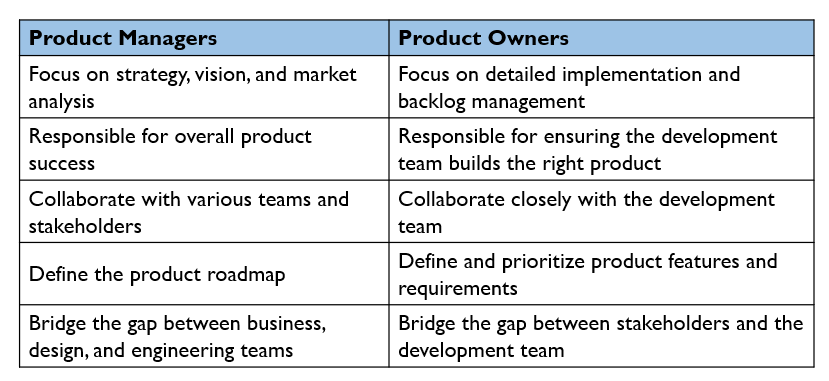Introduction
Do you ever find yourself confused about the roles of a product manager and a product owner? While these roles may sound similar, they actually have distinct responsibilities and play different roles within an organization. In this article, we will dive into the differences between product managers and product owners, providing a clear understanding of their unique functions. Whether you’re interested in pursuing a career in product management or simply curious about these roles, this article will shed light on the key disparities.
Let me start by making it clear that “Product Manager” is a role and a designation in organizations. Product Owner is a role in Scrum (An agile framework) and not a designation. But, the irony is that, some companies now have a ‘Product owner’ designation. Thanks to UNSAFe agile practices – Pun intended! :). A Product Manager in an organization may play the role of a ‘Product owner’ if scrum is implemented as an agile framework. But, for that matter anyone could play the role of a ‘Product owner’ if they can clearly articulate the problem statements and define and prioritize work for the product development team. The Product Manager’s job is much more strategic and they become the best people to take up the role of a ‘Product owner’ to maximize the value of the ‘Product’.
The Role of a Product Manager
Product managers are like the captains of a ship, guiding the entire product development process from the ideation phase to the final product launch. They possess a holistic view of the product and are responsible for its success in the market. Here’s an in-depth look at the main responsibilities of product managers:
1. Strategy Development
Product managers are heavily involved in the strategic aspect of the product. They conduct market research, analyze customer needs and behaviors, and identify business opportunities. Based on these insights, product managers devise a clear product vision and roadmap.
2. Roadmap Creation
A key task for product managers is to create a well-defined roadmap that outlines the product’s development journey. They establish priorities, set milestones, and collaborate with various teams, such as engineering, design, and marketing, to align their efforts with the product’s vision.
3. Stakeholder Management
Product managers act as a bridge between different stakeholders, including executives, developers, marketers, and customers. They effectively communicate the product’s value proposition, gather feedback, and ensure everyone is aligned with the product’s direction.
4. Cross-functional Collaboration
Collaboration is at the heart of a product manager’s role. They work closely with multiple departments, such as engineering, design, and sales, to ensure the successful execution of the product roadmap. Product managers act as the glue that brings these teams together, fostering a collaborative environment.
The Role of a Product Owner
While product managers focus on the strategic aspect of the product, product owners dive into the details of implementation and drive the day-to-day decision-making process. Let’s explore the key responsibilities of product owners:
1. Requirements Management
Product owners are responsible for defining and prioritizing the product’s features and requirements. They work closely with stakeholders, conduct user research, and distill user needs into actionable requirements. They ensure that the development team understands the product vision and collaboratively define the Minimum Viable Product (MVP).
2. Backlog Management
Product owners maintain a product backlog, which is a prioritized list of features, improvements, and bug fixes. They continually refine and reprioritize the backlog based on feedback, market insights, and changing business needs. Their aim is to ensure that the development team is working on the most valuable items at any given time.
3. Sprint Planning and Execution
Product owners collaborate with the development team in sprint planning sessions. They break down the product backlog into smaller, actionable tasks and define the goals for each sprint. During the sprint, product owners provide clarifications, make trade-off decisions, and work closely with the development team to ensure a successful implementation.
4. User Feedback Incorporation
Product owners collect and incorporate user feedback during the development process. They conduct user testing sessions, gather insights from customer support, and collaborate with UX designers to refine the product’s user experience. Their goal is to continuously improve the product based on real user input.
Product Managers v/s Product Owners – A Comparison
Now that we have delved into the core responsibilities of both product managers and product owners, let’s compare and contrast these roles:

“Product managers focus on the big picture, while product owners dive into the details of implementation.”
My friends in Agile consulting / Agile coaching will disagree with this statement of mine, but my perspective is very clear in terms of how the industry has evolved. Some people would like to believe and convince everyone that an “Agile Product Owner” manages the product throughout its entire life-cycle and is the same as a “Product manager”. I would like to caution you here. They are not the same! This state of affairs can also be attributed to Agile training factories churning out so called certified “Product owners” with a 2 days training of Agile methodologies / frameworks. While these certifications themselves could be really helpful, they will not make you ‘Product managers’. Product management is a completely different ball game and much beyond ‘maintaining and prioritizing a backlog’, ‘refining a backlog’ and ‘Sprint planning’. Product management is a very nuanced discipline and it takes months and years of toiling, hard work, discipline, experience, and subject matter expertise.
Conclusion
In today’s fast-paced business environment, understanding the distinctions between a product manager and a product owner is crucial. While product managers concentrate on strategy, vision, and overall product success, product owners drive the detailed implementation and are responsible for ensuring that the development team builds the right product. Both roles are essential for product development and require effective collaboration and communication skills. Also for large Products or Portfolios it is better to keep the two roles separate.
Whether you’re interested in pursuing a career in product management or working closely with product teams, comprehending the differences between these roles will undoubtedly strengthen your understanding of the product development process. So, next time you come across these terms, remember the unique responsibilities that distinguish a product manager from a product owner.
*Disclaimer: The thoughts expressed in this article are my personal opinions. They are based on my experiences in the industry. Scrum is an amazing framework and I was first introduced to it in 2012 when Walmart embarked on an agile journey. It helped me become good at agile practices as a Product owner (While I was also a Product manager). But a Product Owner in scrum may not necessarily be a Product manager.



